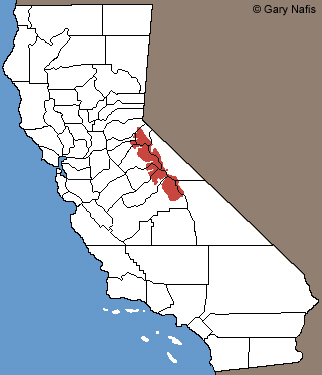|
| Adult Males |
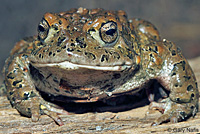 |
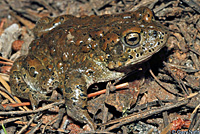 |
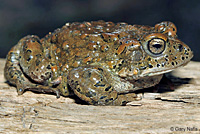 |
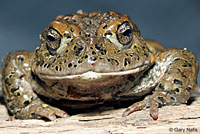 |
| |
Adult male, Alpine County |
|
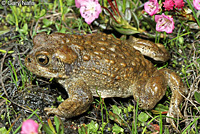 |
 |
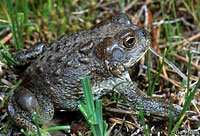 |
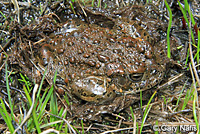 |
| Adult Male, Alpine County |
Adult Male, Alpine County |
Adult Male, Alpine County |
Adult male in calling position, Alpine County, hunkered down in a small self-made cavity in a meadow. |
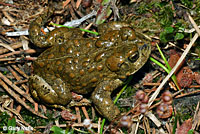 |
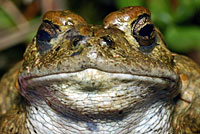 |
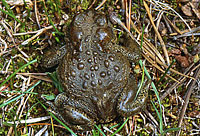 |
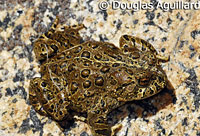 |
| Adult male, Alpine County |
Adult male, Alpine County |
Adult male, Mono County
© Douglas Aguillard |
 |
 |
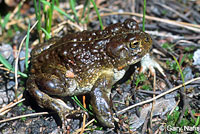 |
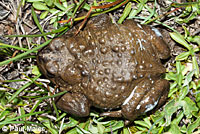 |
| This adult male sat at the edge of a small trickle at the edge of a small lake in Alpine County for several hours, probably feeding on insects. |
Adult male, Alpine County |
Male, Tuolumne County
© Paul Maier |
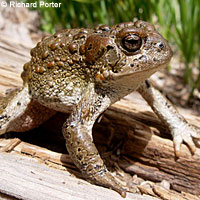 |
 |
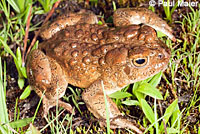 |
Adult male, raised up in a defensive stance, Alpine County © Richard Porter
|
Adult female (left) and male,
Fresno County © Patrick Briggs |
Male, Tuolumne County
© Paul Maier |
| |
|
|
|
| Male Yosemite Toads With an Unusual Appearance |
 |
 |
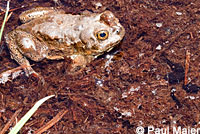 |
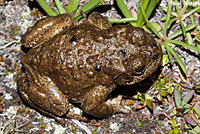 |
| Male with unusually reddish coloration, Tuolumne County © Paul Maier |
Melanistic adult male, Mariposa County
© Paul Maier |
Oddly-pigmented male in pond with tadpoles, Mariposa County © Paul Maier |
Adult male with unidentified dorsal black spots, possibly from a disease, parasite, or genetic mutation, Fresno County
© Paul Maier |
| |
|
|
|
| Adult Females |
 |
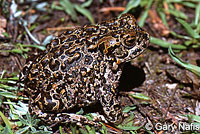 |
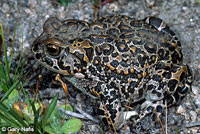 |
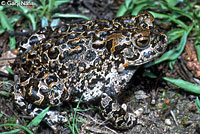 |
| Adult Female, Alpine County |
Adult Female, Alpine County |
Adult Female, Alpine County |
Adult Female, Alpine County |
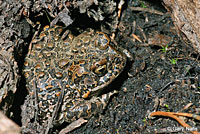 |
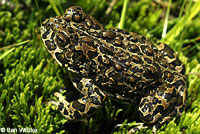 |
 |
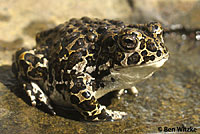 |
Adult female in a small meadow cavity, Alpine County
|
Adult female, Mono County
© Ben Witzke |
Adult female, Mono County
© Ben Witzke |
Adult female, Mono County
© Ben Witzke
|
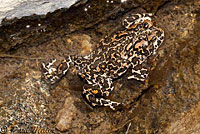 |
 |
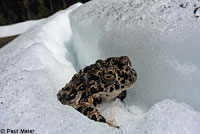 |
 |
Adult female, Fresno County
© Paul Maier |
Adult female, Fresno County
© Paul Maier |
Adult female wedged between two snow banks while migrating to the breeding pond Tuolumne County © Paul Maier |
Adult female, Tuolumne County
© Paul Maier |
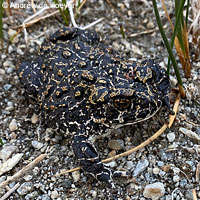 |
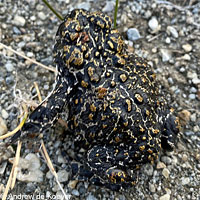 |
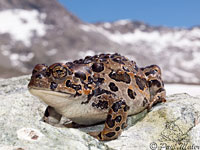 |
|
Very dark adult female with a lot of black coloring,
Mono County © Andrew de Koeyer |
Adult female, Fresno County
© Paul Maier |
|
| |
|
|
|
| Juveniles |
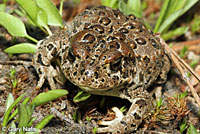 |
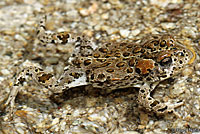 |
 |
 |
Juvenile, Alpine County
|
Juvenile, Alpine County |
Juvenile, showing typical orange tubercles on the palms of their hands and feet, Fresno County © Paul Maier |
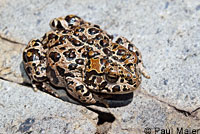 |
 |
|
|
Juvenile, Tuolumne County
© Paul Maier |
Juvenile, Tuolumne County
© Paul Maier |
|
|
| |
|
|
|
Reproduction, Eggs, and Tadpoles
(See More Pictures Here) |
 |
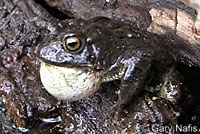 |
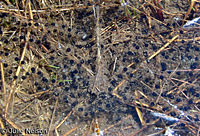 |
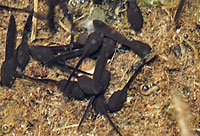 |
| Adults in amplexus with the female depositing her eggs, Alpine County |
Calling male, Alpine County |
Eggs, Fresno County
© Julie Nelson |
Tadpoles, Alpine County |
| |
|
|
|
| Habitat |
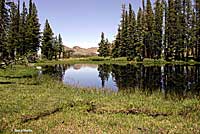 |
 |
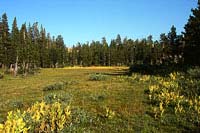 |
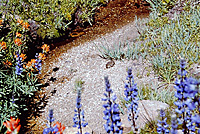 |
Habitat, 8,900 ft, Alpine County
|
Breeding habitat, 8900 ft., Alpine County (site of amplexing adults and eggs shown above is in shallow water at lower left) |
Habitat, Alpine County |
Toad in habitat in late summer (in the center of the photo on the bank of a small creek) 8,800 ft., Alpine County. |
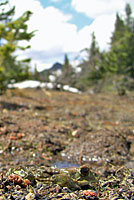 |
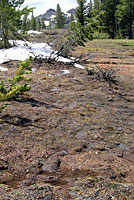 |
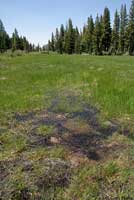 |
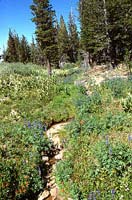 |
Adult male, Alpine County, (at very bottom of pictures) at edge of snow-melt runoff in a meadow in which there are a few calling males during the beginning of the breeding season.
|
Tadpoles habitat, 8,900 ft,. Alpine County |
Habitat, Alpine County |
 |
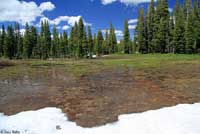 |
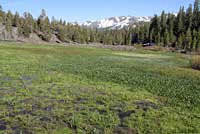 |
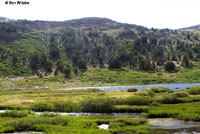 |
Habitat at breeding time - meadow saturated with
snow melt 8,900 ft., Alpine County.
|
Former habitat, 9,100 ft. Mono County |
Habitat, Mono County © Ben Witzke |
 |
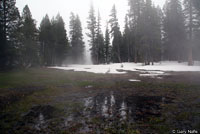 |
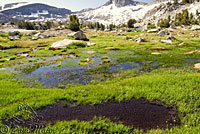 |
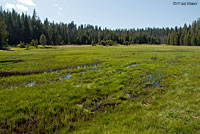 |
Two views of breeding habitat at 9200 ft. elevation in Fresno County
during the breeding period just after snow melt in late May.
|
Subalpine habitat in breeding season, with pond in foreground showing tadpole divots, Fresno County © Paul Maier |
Habitat in breeding season,
Mariposa County © Paul Maier |
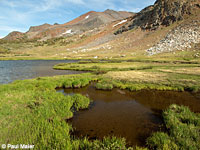 |
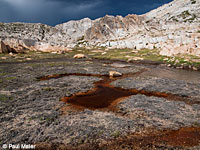 |
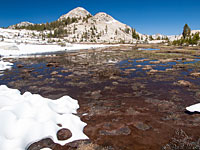 |
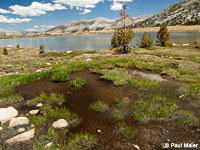 |
Subalpine habitat, Tuolumne County
© Paul Maier |
Subalpine habitat, Tuolumne County
© Paul Maier |
Subalpine habitat, Tuolumne County
© Paul Maier |
Subalpine habitat, Tuolumne County
© Paul Maier |
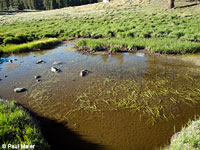 |
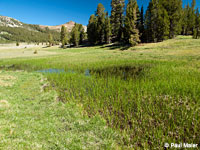 |
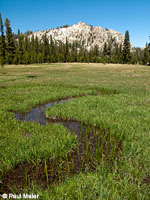 |
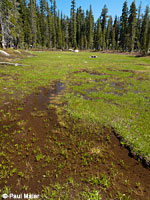 |
Transitional habitat, Tuolumne County
© Paul Maier |
Transitional habitat, Tuolumne County
© Paul Maier |
Transitional habitat, Tuolumne County
© Paul Maier |
Montane habitat, Tuolumne County
© Paul Maier |
| |
|
|
|
| Short Videos |
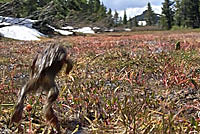 |
 |
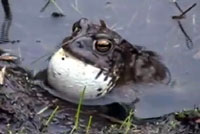 |
 |
| Male Yosemite Toads swim and hop around a meadow surrounded by melting snow. |
Juvenile and adult male Yosemite Toads around a high-elevation lake. |
This is a 20 second video of a male toad calling in the afternoon from a snow-melt pool in a high-altitude wet meadow surrounded by snow at 9200 ft. elevation in Fresno County. The air temperature was 37 degrees, but the shallow water was over 60 degrees F. due to the sun. Pacific Treefrogs and water sounds are heard in the background.
Many thanks to Stephanie Weber, aquatic biologist and toad Muse, for helping me to get this recording by inspiring some cold and sluggish toads to call. |
This is a short video of a male and female in amplexus in Fresno County. A release call, probably made by the female (on the bottom), can be heard as the frogs hop together. A female typically produces this call after she has already laid her eggs and wants the male to release her.
© Julie Nelson
|
 |
 |
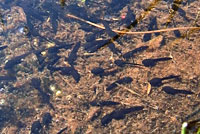 |
 |
These are short videos of a male calling from on top of and underneath
a piece of buried tree root in a wet meadow in Alpine County. |
Tiny recently-hatched tadpoles swim in shallow puddles in a high mountain meadow in Alpine County |
A juvenile toad in Alpine County. |
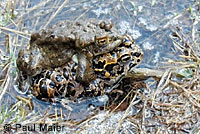 |
|
|
|
A short video of adults in amplexus hopping around the breeding pond in Tuolumne County. You can hear the female making a faint release call.
© Paul Maier |
|
|
|
| |
|
|
|
|
Description |
| |
| Size |
Adults are 1.25 - 2.74 inches from snout to vent ( 4.4 - 6.9 cm). (Stebbins, 2003)
|
|
| Appearance |
A robust and stocky toad with dry, uniformly warty skin.
No cranial crests are present.
Parotoid glands are large, flat, and oval.
Eyes are closely set with horizontal pupils.
A dorsal stripe is very faint or absent.
|
| Color and Pattern |
Male and females are very different in appearance.
Males are pale yellowish green or olive above, with few or no dark blotches.
Females and young are heavily blotched on a light background.
The throat and belly are pale on both sexes. |
| Male/Female Differences |
| Besides the differences in color and pattern described above, males are smaller than females and have fewer and smaller warts. |
| Young |
Young have no dorsal stripe immediately after transformation.
The bottoms of their feet is bright orange or yellow. |
| Larvae (Tadpoles) |
Tadpoles are very dark brown, possibly as a protection from ultraviolet solar radiation which is very strong at the high elevation locations inhabited by these toads
Eyes are inset from the edges of the head on the top.
The tip of the tail is rounded.
Tadpoles grow to about 1.5 inches (3.7 cm) in length before undergoing metamorphosis. (Stebbins & McGinnis 2012)
|
|
| Life History and Behavior |
| Activity |
Active mostly in daytime, usually in sunny areas, where basking in sunlight is needed to maintain an optimal body temperature.
Activity period is relatively short, from April - July, to late September - early October.
|
| Overwintering |
| During winter, Yosemite Toads shelter in the burrows of small mammals, willow thickets, forest edges adjoining meadows, and in clumps of vegetation near water. |
| Movement |
| Like most toads, this one is slow moving, often using a walking or crawling motion along with short hops. |
| Defense |
For defense Yosemite toads rely on
parotoid glands and warts which can secrete a poison that deters some predators.
They may also retreat into burrows or jump into water to hide from threats. |
Territoriality
|
Calling males at breeding sites will defend their territory against intrusion by other males.
|
| Longevity |
Kagarise Sherman and Morton (1984) estimated that females may live at least 15 years and males at least 12 years.
(Kagarise Sherman, 1980 - referenced in Davidson and Fellers, Lanoo 2005) |
| Voice (Listen) |
| A long, loud, rapid musical trill, repeated at frequent intervals. |
| Diet |
| Diet consists of a wide variety of invertebrates, including beetles, ants, siders, bees, wasps, flies, and millipedes. The prey is located by vision, then the toad lunges with a large sticky tongue to catch the prey and bring it into the mouth to eat. |
| Reproduction |
Reproduction is aquatic.
Fertilization is external, with the male grasping the back of the female and releasing sperm as the female lays her eggs.
Amplexus is axillary - the male grabs the female around her shoulders or armpits.
The reproductive cycle is similar to that of most North American Frogs and Toads. Mature adults come into breeding condition and migrate to ponds or ditches where the males call to advertise their fitness to competing males and to females. Males and females pair up in amplexus in the water where the female lays her eggs as the male fertilizes them externally. The adults leave the water and the eggs hatch into tadpoles which feed in the water and eventually grow four legs, lose their tails and emerge onto land where they disperse into the surrounding territory.
Females are reproductively mature at 4–6 years of age, but do not breed every year.
Males first breed when they are 3–5 years old. (Kagarise Sherman, 1980 - referenced in Davidson and Fellers, Lanoo 2005)
Mating and egg-laying takes place from May to July shortly after the snow melts in shallow pools in meadows, the margins of lakes and quiet streams.
Males arrive at breeding sites a few days before females. (Males stay for 1 - 2 weeks, while females leave after a few days.)
Males set up a territory in shallow water and make a trilled breeding call to attract a female. Calls are made during the day, peaking at mid day. When a female arrives, the male amplexes her and rides her to a location where she decides to lay her eggs.
|
| Eggs |
Darkly-pigmented eggs are laid
in strings of single or double strands or in a radiating network several eggs deep in shallow pools and slow moving meadow streams.
Females laid an estimated 1,500 to 2,000 eggs at one location.
Eggs hatch in 10 - 12 days. |
| Tadpoles and Young |
Tadpoles metamorphosed in 52 - 63 days at one location.
Tadpoles are preyed upon by other frogs, birds, diving beetles, and probably gartersnakes.
Juvenile toads feed and overwinter near the breeding pond, in small burrows or root tangles.
|
|
| Hybrids |
Hybridizes with A. b. halophilus in the northern part of its range. (Stebbins 2003.)
|
|
| Habitat |
Inhabits wet mountain meadows, willow thickets, and the borders of forests, usually not more than a hundred meters from permanent water.
After breeding, males and females move from the breeding pond into meadows where they feed for 2 - 3 months before the snows return.
|
|
| Geographical Range |
Endemic to California.
Found only at high elevations in the Sierra Nevada Mountains.
Most authors indicate that the distribution is from the Ebbets Pass area of Alpine County south to the Spanish Mountains area in Fresno County, but there are mentions of Yosemite Toads from farther north than Ebbets Pass: Stebbins (2003/2012) notes their northernmost range as Grass Lake, El Dorado County (just north of the Alpine County line) and there are museum specimens from 1956 taken from Fallen Leaf Lake, El Dorado County, which is just south of Lake Tahoe.
Range map information courtesy of Paul Maier, San Diego State University. |
| Elevational Range |
Found at elevations of
4,800 - 12,000 ft. (1,460 - 3,630 m.) (Stebbins & McGinnis, 2012)
"Elevational range from 6,400 ft./1951 m, at Aspen Valley, to 11,300 ft./ 3444 m, on southeastern slope of Mt. Dana (both Tuolumne Co.)" (Hansen & Shedd, 2025)
|
|
| Notes on Taxonomy |
Formerly included in the genus Bufo. In 2006, Frost et al replaced the long-standing genus Bufo in North America with Anaxyrus, restricting Bufo to the eastern hemisphere. Bufo is still used in most existing references (in 2013).
-------------------------------------------------------------------------------------------------------------------------------------------------------------------------------------------------------------------------------
Nicholson, K. E. (ed.). 2025 SSAR Scientific and Standard English Names List mentions two distinct clades of A. canorus:
"Multiple studies (e.g., Goebel et al., 2009, Molecular Phylogenetics and Evolution 50: 209–225, and Gordon et al., 2017, Zootaxa 4290: 123–139) have found two phylogenetically distinct mitochondrial DNA clades of this species, corresponding to samples from the southern Sierra Nevada range and northern samples from the same range. Goebel et al. (op. cit.) also reported hybrids between A. boreas and A. canorus. ... these issues require more research that is expanded to include nuclear DNA."
-------------------------------------------------------------------------------------------------------------------------------------------------------------------------------------------------------------------------------
Alternate and Previous Names (Synonyms)
Bufo canorus - Yosemite Toad (Stebbins 1954, 1966, 1985, 2003, Stebbins & McGinnis 2012)
Bufo canorus - Yosemite Toad (Yosemite Park Toad) (Wright and Wright 1949)
Bufo canorus - Yosemite Park Toad (Storer 1925)
Bufo canorus - Yosemite Park Toad (Grinnell and Camp 1917)
Bufo canorus (Camp 1916)
|
|
| Conservation Status |
It has been estimated from population studies that the Yosemite Toad has disappeared from over 50% of its historic range, even in habitats that still appear to be unaltered. Remaining populations may not be reproducing enough to survive. One population at Tioga Pass, counted for more than 20 years, had declined by 90 percent in 1993.
The causes of the decline are unclear. Disease, degradation of habitat by grazing livestock, increased ultraviolet radiation, introduced predatory fishes, a severe 1980's drought, windborne pesticide contamination, and increased predation by Common Ravens, whose population has increased greatly due to human activities, are all causes which are thought to have contributed to the decline.
Proposed for Federal ESA Threatened listing 4/25/13.
Federally listed as Threatened under the Endangered Species Act 4/25/14.
In August, 2016, the U.S. Fish and Wildlife Service announced the designation of 1.8 million acres of protected critical habitat in the Sierra Nevada mountains for Rana sierrae, the Sierra Nevada Yellow-legged Frog, the northern population of Rana muscosa, the Southern Mountain Yellow-legged Frog, and Anaxyrus canorus, the Yosemite Toad. BiologicalDiversity.org
In late June, 2024, 118 Yosemite Toads were transported to Yosemite National Park from the San Francisco Zoo, where they were raised. They were released into a meadow the toads formerly inhabited before much of it was destroyed by a fire 11 years before. The toads were microchipped and will be monitored and tracked through a radio telemetry project. This is the first time the species has been raised in captivity and released into the wild.
|
|
|
Taxonomy |
| Family |
Bufonidae |
True Toads |
Gray, 1825 |
| Genus |
Anaxyrus |
North American Toads |
Tschudi, 1845 |
| Species |
canorus |
Yosemite Toad
|
(Camp, 1916) |
|
Original Description |
Bufo canorus Camp, 1916 - Univ. California Publ. Zool., Vol. 17, No. 6, p. 59
from Original Description Citations for the Reptiles and Amphibians of North America © Ellin Beltz
|
|
Meaning of the Scientific Name |
Anaxyrus - Greek = A king or chief
canorus - Latin = tuneful - "melodious trill uttered by this toad" - referring to the male's breeding call
Taken in part from Scientific and Common Names of the Reptiles and Amphibians of North America - Explained © Ellin Beltz
|
|
Related or Similar California Frogs |
Anaxyrus boreas boreas
Anaxyrus boreas halophilus
Anaxyrus woodhousii
Anaxyrus californicus
Anaxyrus exsul
|
|
More Information and References |
NatureServe Explorer
AmphibiaWeb
California Department of Fish and Game
Hansen, Robert W. and Shedd, Jackson D. California Amphibians and Reptiles. (Princeton Field Guides.) Princeton University Press, 2025.
Stebbins, Robert C., and McGinnis, Samuel M. Field Guide to Amphibians and Reptiles of California: Revised Edition (California Natural History Guides) University of California Press, 2012.
Stebbins, Robert C. California Amphibians and Reptiles. The University of California Press, 1972.
Flaxington, William C. Amphibians and Reptiles of California: Field Observations, Distribution, and Natural History. Fieldnotes Press, Anaheim, California, 2021.
Nicholson, K. E. (ed.). 2025. Scientific and Standard English Names of Amphibians and Reptiles of North America North of Mexico, with Comments Regarding Confidence in Our Understanding. Ninth Edition. Society for the Study of Amphibians and Reptiles. [SSAR] 87pp.
Samuel M. McGinnis and Robert C. Stebbins. Peterson Field Guide to Western Reptiles & Amphibians. 4th Edition. Houghton Mifflin Harcourt Publishing Company, 2018.
Stebbins, Robert C. A Field Guide to Western Reptiles and Amphibians. 3rd Edition. Houghton Mifflin Company, 2003.
Behler, John L., and F. Wayne King. The Audubon Society Field Guide to North American Reptiles and Amphibians. Alfred A. Knopf, 1992.
Robert Powell, Roger Conant, and Joseph T. Collins. Peterson Field Guide to Reptiles and Amphibians of Eastern and Central North America. Fourth Edition. Houghton Mifflin Harcourt, 2016.
Powell, Robert., Joseph T. Collins, and Errol D. Hooper Jr. A Key to Amphibians and Reptiles of the Continental United States and Canada. The University Press of Kansas, 1998.
American Museum of Natural History - Amphibian Species of the World 6.2
Bartlett, R. D. & Patricia P. Bartlett. Guide and Reference to the Amphibians of Western North America (North of Mexico) and Hawaii. University Press of Florida, 2009.
Elliott, Lang, Carl Gerhardt, and Carlos Davidson. Frogs and Toads of North America, a Comprehensive Guide to their Identification, Behavior, and Calls. Houghton Mifflin Harcourt, 2009.
Lannoo, Michael (Editor). Amphibian Declines: The Conservation Status of United States Species. University of California Press, June 2005.
Storer, Tracy I. A Synopsis of the Amphibia of California. University of California Press Berkeley, California 1925.
Wright, Albert Hazen and Anna Wright. Handbook of Frogs and Toads of the United States and Canada. Cornell University Press, 1949.
Basey, Harold E. Discovering Sierra Reptiles and Amphibians. Yosemite Association and Sequoia Natural History Association, 1976, 1991.
Davidson, Carlos. Booklet to the CD Frog and Toad Calls of the Pacific Coast - Vanishing Voices. Cornell Laboratory of Ornithology, 1995.
Robert C. Thomson, Amber N. Wright, and H. Bradley Shaffer. California Amphibian and Reptile Species of Special Concern. University of California Press, 2016.
Joseph Grinnell and Charles Lewis Camp. A Distributional List of the Amphibians and Reptiles of California. University of California Publications in Zoology Vol. 17, No. 10, pp. 127-208. July 11, 1917.
|
|
|
The following conservation status listings for this animal are taken from the July 2025 State of California Special Animals List and the July 2025 Federally Listed Endangered and Threatened Animals of California list (unless indicated otherwise below.) Both lists are produced by multiple agencies every year, and sometimes more than once per year, so the conservation status listing information found below might not be from the most recent lists, but they don't change a great deal from year to year.. To make sure you are seeing the most recent listings, go to this California Department of Fish and Wildlife web page where you can search for and download both lists:
https://www.wildlife.ca.gov/Data/CNDDB/Plants-and-Animals.
A detailed explanation of the meaning of the status listing symbols can be found at the beginning of the two lists. For quick reference, I have included them on my Special Status Information page.
If no status is listed here, the animal is not included on either list. This most likely indicates that there are no serious conservation concerns for the animal. To find out more about an animal's status you can also go to the NatureServe and IUCN websites to check their rankings.
Check the current California Department of Fish and Wildlife sport fishing regulations to find out if this animal can be legally pursued and handled or collected with possession of a current fishing license. You can also look at the summary of the sport fishing regulations as they apply only to reptiles and amphibians that has been made for this website.
Special Animals List Notes:
1) Formerly Bufo canorus; Frost, Grant, Faivovich, Bain, Haas, Haddad, De Sá, Channing, Wilkinson, Donnellan, Raxworthy, Campbell, Blotto, Moler, Drewes, Nussbaum, Lynch, Green & Wheeler (2006. The Amphibian Tree of Life. Bulletin of the American Museum of Natural History 297: 1-370) placed this species in the genus Anaxyrus (Tschudi, 1845). The standard common name remains Yosemite toad.
2) The USFWS published a final rule on April 29, 2014, to list the Yosemite toad as Threatened. The effective date for this rule is June 30, 2014.
|
| Organization |
Status Listing |
Notes |
| NatureServe Global Ranking |
G2G3 |
Imperiled - Vulnerable |
| NatureServe State Ranking |
S2S3 |
Imperiled - Vulnerable |
| U.S. Endangered Species Act (ESA) |
FT |
Listed as Threatened 6/30/2014 |
| California Endangered Species Act (CESA) |
None |
|
| California Department of Fish and Wildlife |
SSC |
Species of Special Concern |
| Bureau of Land Management |
None |
|
| USDA Forest Service |
S |
Sensitive |
| IUCN |
EN |
Endangered |
|
|
|
